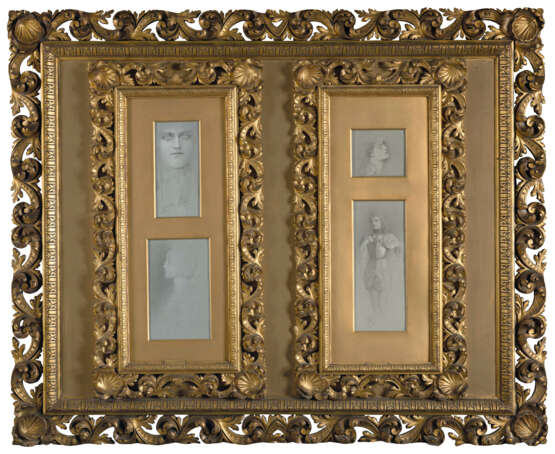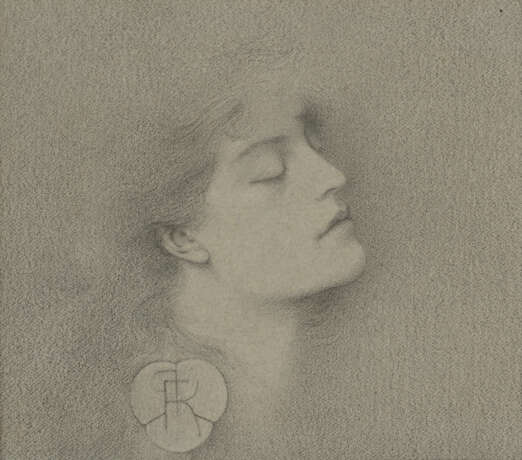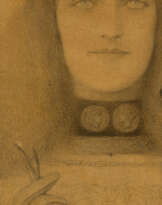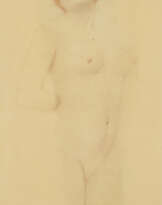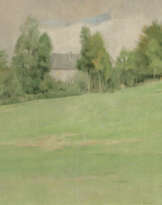ID 922529
Lot 93 | FERNAND KHNOPFF (TERMONDE 1858-1921 BRUXELLES)
Estimate value
€ 200 000 – 300 000
Deux études pour un Sphinx ; Deux études pour Victoria
monogrammé ‘FK’ dans un trèfle trilobé (sur chaque dessin)
pierre noire, craie blanche sur papier gris bleu
19 x 9 cm (7 1/2 x 3 1/2 in) ; 20 x 12,5 cm (7 7/8 x 4 7/8 in) ; 9,5 x 11 cm (3 3/4 x 4 3/8 in.) ; 26 x 10,5 cm (10 1/4 x 4 1/8 in.) ; dans leur cadre d'origine
Provenance
Madame Landuyt, Termonde.
Etienne Taymans, Bruxelles.
Avec galerie Patrick Derom, Bruxelles.
Collection particulière belge.
Literature
W. Shaw-Sparrow, ‘Fernand Khnopff’, in The Magazine of Art, Londres, Décembre 1890, p. 43, n° CR 129.
X, 'Aux XX', in La Gazette, Bruxelles, 9 février 1892.
E. Louis, ‘L'Exposition d'Aquarelles à Anvers’, in La Fédération Artistique, Bruxelles, 1er mai 1892, p. 331, n° 28.
P. de Mont, ‘Fermand Khnopff’, in Elsevier’s Geïllustreerd Maandschrift, Amsterdam, 1896, XI, p. 499, n° 6.
P. de Mont, ‘Fernand Khnopff’, in Het Schildersboek, Amsterdam, 1901, p. 151.
R. Delevoy, C. de Croës, G. Ollinger-Zinque, Fernand Khnopff, Bruxelles, 1987, p. 247, n° 129-130, p. 276, n° 210a-210b.
G. Ollinger-Zinque, ‘Les artistes belges et la 'Rose+Croix’, in Bulletin, Musées royaux des Beaux-Arts de Belgique, 1-3, Bruxelles, 1989-1991, p. 460.
M. Draguet, Khnopff ou l’ambigü poétique, Bruxelles, 1995, p. 286, 316, 368, fig. 284, 309, 356-357.
M. Bisanz-Prakken, ‘Khnopf, Toorop, Minne und die Wiener Moderne’, in Sehnsucht nach Glück, Wiens aufbruch in die Moderne: Klimt, Kokoschka, Schiele, cat. exp., Francfort, 1995, p. 173, n° CR129.
M. Draguet, Fernand Khnopff, Bruxelles, 2018, pp. 136-137, figs. 86, 87, 88.
Exhibited
Deux études pour un Sprinx
Namur, musée des Beaux-Arts, VIIe Exposition internationale et triennale des Beaux-Arts, 1889, n° 405-406.
Den Haag, Panorama Mesdag, Derde Tentoonstelling der Nederlandsche Etsclub, n° 33-34.
Londres, Hanover Gallery, Fernand Khnopff Exhibition, 1890, n° 3-19.
Bruxelles, Musée d'Art Moderne, Les XX, Neuvième Exposition annuelle, 1892, n°1.
L'ensemble des quatres études dans leur cadre d'origine
Anvers, Exposition d'Aquarelles, Pastels, Dessins, Gravures et Sculptures. Exposition des Membres de la Société royale belge des Aquarellistes, 1892, n°60a, 61b, 62c, 63d.
Paris, Palais du Champ de Mars, Second Salon de la Rose+Croix, 1893, n° 121-122.
Paris, Musée des Arts Décoratifs, Bruxelles, Musée des Beaux-Arts, Fernand Khnopff, 1979-1980, n° 69.
Hambourg, Kunsthalle, Im Lebenstraum gefangen, Fernand Khnopff, 1980, n° 69.
Tokyo, Bunkamura Museum of Art, Himeji City Museum of Art, Nagoya, Nagoya City Art Museum, Yamanashi, Yamanashi Prefectural Museum of Art, Fernand Khnopff, 1990, n° 23.
Bruxelles, Musée des Beaux-Arts, Salsbourg, Museum der Modern, Fernand Khnopff, 2004, n° 113.
Den Haag, Gemeentemuseum, Toorop in Wenen: inspiratie voor Klimt, 2006-2007, n° 16a-d.
Post lot text
FERNAND KHNOPFF, TWO STUDIES FOR A SPHINX; TWO STUDIES FOR VICTORIA, BLACK AND WITHE CHALK ON GREY-BLUE PAPER
Created by the leading figure of Belgian Symbolism, this impressive set of four female studies on blue paper and arranged in pairs, were united in a large ornate gilt wooden frame in 1892 by the artist himself. The same year, the work was shown in the present form for the first time at an exhibition in Antwerp in 1892.
Two studies for a Sphinx
In the first face study at the top left, Khnopff highlights the powerful and hypnotic gaze of this Sphinx with its disproportionately long neck and fine facial features which contrast with the almost absent hair with stumped graphite. The tight mise-en-cadre can be found in a circular drawing (private collection, New York; see Delevoy, de Croës and Ollinger-Zinque, op. cit., no. 274, ill.), which was made in preparation for the painting Des Caresses, at the Musées Royaux des Beaux-Arts de Belgique in Brussels (inv. 6768; see Delevoy, de Croës and Ollinger-Zinque, op. cit., no. 275, ill.).
The second drawing takes the elegant profile of a late fifteenth-century marble sculpture of a young woman by the Italian Francesco Laurana, now in the Louvre, of which Khnopff probably owned a copy (fig. 1; inv. MR 2597; see J. Howe, Fernand Khnopff. Two Studies for Studies for Victoria, Brussels, New York, Patrick Derom Gallery, 2011, p. 15, n. 28). This same sculpture would inspire Khnopff on several occasions throughout his career; it is notably found in the background of a painted portrait of Eugénie Verhaeren (private collection; see Delevoy, de Croës and Ollinger-Zinque, op. cit., no. 107, ill.).
Two Studies for Victoria
In the first drawing of the pair on the right, Khnopff depicts a face with precise features that contrasts with barely sketched hair and closed eyes: the young woman seems to be immersed in a dreamlike world. The face gives the impression of a motionless, timeless mask, and Véronique Coomans-Cardon believes that the artist must have copied it from a plaster bust that he had in his possession (op. cit., 2004, p. 179). This face has also been compared to a painting ‘Beata Beatrix’ (1874) by the Pre-Raphaelite Dante Gabriel Rossetti (1828-1882) in honour of his deceased wife Elizabeth Siddal (fig. 2; Tate Gallery, London, inv. N01279). In this painting, the appeased woman is depicted at the moment of her passage to the afterlife, accepting the invisible kiss of Death who comes to fetch her, having also been interpreted as a desire for loving abandonment.
The second drawing of this pair represents a medieval knight in armour. The composition echoes a pastel titled Victoria. Like flames, the long red hair in a private collection (fig. 3; see Delevoy, de Croës and Ollinger-Zinque, op. cit., no. 211, ill.). The androgynous figure is also represented in Khnopff’s first polyptych, L’Isolement, produced between 1890 and 1894, consisting of three works: Acrasia and Britomart (Musée d’Art Modern et d’Art Contemporain, Liège) and Solitude (Foundation Neuman, Gingins; see Delevoy, de Croës and Ollinger-Zinque, op. cit., nos. 164a-164c, ill.). Here, according to Michel Draguet, the knight personifies solitude in the face of desire (op. cit., p. 137).
It was not until the first retrospective of his work in 1979 in Paris, Brussels and Hamburg that Fernand Khnopff was rediscovered, alongside other Symbolist artists of his time. This set of four studies contributed to revival of the artist by appearing in this 1979 exhibition, as well as in the one organised more recently in Brussels in 2004.
Fig. 1. Dante Gabriel Rossetti, Beata Beatrix. Tate Gallery, London.
Fig. 2. Fernand Khnopff, Victoria. Private collection.
| Artist: | Fernand Knopff (1858 - 1921) |
|---|---|
| Applied technique: | Pencil, Charcoal |
| Medium: | Acrylic glass, Wood, Plastic |
| Place of origin: | Belgium, Western Europe, Europe |
| Auction house category: | All other types of objects, Drawings |
| Artist: | Fernand Knopff (1858 - 1921) |
|---|---|
| Applied technique: | Pencil, Charcoal |
| Medium: | Acrylic glass, Wood, Plastic |
| Place of origin: | Belgium, Western Europe, Europe |
| Auction house category: | All other types of objects, Drawings |
| Address of auction |
CHRISTIE'S 9 Avenue Matignon 75008 Paris France | ||||||||||||||
|---|---|---|---|---|---|---|---|---|---|---|---|---|---|---|---|
| Preview |
| ||||||||||||||
| Phone | +33 (0)1 40 76 85 85 | ||||||||||||||
| Fax | +33 (0)1 40 76 85 86 | ||||||||||||||
| Conditions of purchase | Conditions of purchase | ||||||||||||||
| Shipping |
Postal service Courier service pickup by yourself | ||||||||||||||
| Payment methods |
Wire Transfer | ||||||||||||||
| Business hours | Business hours
|
